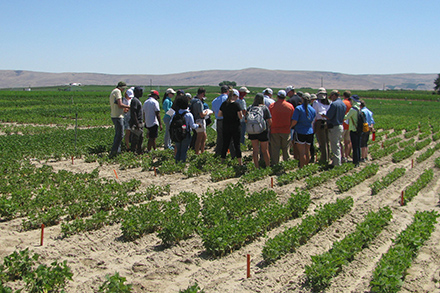
Fit, Fabulous Fabaceae
"Purgatory plots" test new beans against harsh conditions to pick winners
Nearly three decades in, Phil Miklas, a research geneticist at the Grain Legume Genetics Physiology Research Unit work site in Prosser, WA, is still finding ways to make beans better. By putting the beans to the test against a range of trials – of temperature, water levels, disease, and soil conditions – Miklas winnows the gene pool, selecting those hardy survivors that withstand it all. The challenges to the beans are practically biblical in scope, which is why Miklas and his collaborators have called their fields, aptly enough, the "purgatory plots." These plots stand in stark contrast to a second set of fields, where the scientists provide beans with ideal growing conditions: abundant water, fertile soil, and more – bean heaven. In the end, Miklas identifies those beans that perform best in both plots and, with the interest of industry partners, deems them ready to be marketed as distinct new cultivars.
Lately, he and his team have been quite busy, readying five new cultivars for release. Two of them, dubbed ‘USDA Rattler’ and ‘USDA Diamondback’ for their serpentine toughness, are already in the marketplace, and now grow on more than 40,000 acres in the U.S., their spread limited only by the availability of the sold-out seed stock. In addition to their hardiness in the face of heat, drought, and more, they offer other features that make them appealing: Diamondback is a so-called "slow-darkening" variety that does not become darker over time in storage, as many beans do. Its stay-bright color makes it more appealing to international consumers, boosting export market sales.
 ARS research geneticist Phil Miklas stands in front of a dry bean breeding trial under low nitrogen fertility stress in Paterson, WA. (Photo credit: Mark Seymour, ARS)
ARS research geneticist Phil Miklas stands in front of a dry bean breeding trial under low nitrogen fertility stress in Paterson, WA. (Photo credit: Mark Seymour, ARS)
More recently, Miklas and his collaborators have developed three additional varieties: pinto beans named ‘USDA Basin’ and ‘USDA Cody,’ and a small red bean called ‘USDA Lava,’ for its distinct color. The three have demonstrated yield potential from 96-121% of well-known varieties. All three are well-suited to the Pacific Northwest, one of the nation’s foremost bean-growing regions; Basin performs best in the Columbia and Snake River Basins, while Cody also does well outside the area in the Intermountain and Northern Plains regions. All five varieties are currently, or will be, available through seed companies.
According to Miklas, the beans’ robust nature means that farmers will potentially need fewer inputs to grow them, saving both money and effort.
 The dry bean harvest crew (left to right: Jeff Colson, Susan Swanson, Treva Anderson, Phil Miklas, and Alex Zepeda) for the non-stress breeding trials stands in one of their research fields in Othello, WA. (Photo by John Steinbock).
The dry bean harvest crew (left to right: Jeff Colson, Susan Swanson, Treva Anderson, Phil Miklas, and Alex Zepeda) for the non-stress breeding trials stands in one of their research fields in Othello, WA. (Photo by John Steinbock).
"The hope is that we could reduce fertilizer use," he said. "These materials also provide an opportunity to use less water. Our snowpack is below normal here, so these beans would be amenable to rationing in this type of climate when you have low water availability, and then they also have the opportunity to do better across the country where you have drought."
The beans are also grown without the use of some inputs that are standard in much of the industry.
"We never use seed treatment, so we’re also selecting for materials that get out of the ground on their own, without the help of fungicides and insecticides. Our material should do really well under low-input systems, sustainable farming systems, and even organic systems, since they’ve been bred for that."
 A WSU graduate student plant pathology class visits the dry bean ‘Purgatory Plot’ in Prosser, WA. (Photo by Lindsey du Toit)
A WSU graduate student plant pathology class visits the dry bean ‘Purgatory Plot’ in Prosser, WA. (Photo by Lindsey du Toit)
Once they’ve emerged, the plants are also resistant to some of the most common scourges of beans, such as bean common mosaic virus, curly top virus, and bean rust, a fungal pathogen that is common in bean-growing regions east of the Continental Divide.
Ultimately, Miklas hopes that making it easier and more profitable to grow beans will increase their popularity among both farmers and consumers. He has reason to be optimistic, based on his team’s past successes; his unit’s team has contributed to 70% of the new dry bean cultivars that have been released through public breeding programs over the last 10 years. And when it comes to the potential of beans, Miklas remains a believer.
"Probably even more important than developing these varieties is having people eat more beans," he said. "They are really good for you, in so many ways. They’re kind of a super-food, actually." — By Kathryn Markham, ARS Office of Communications
